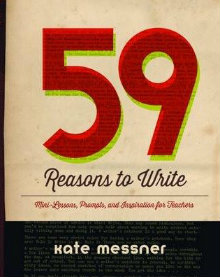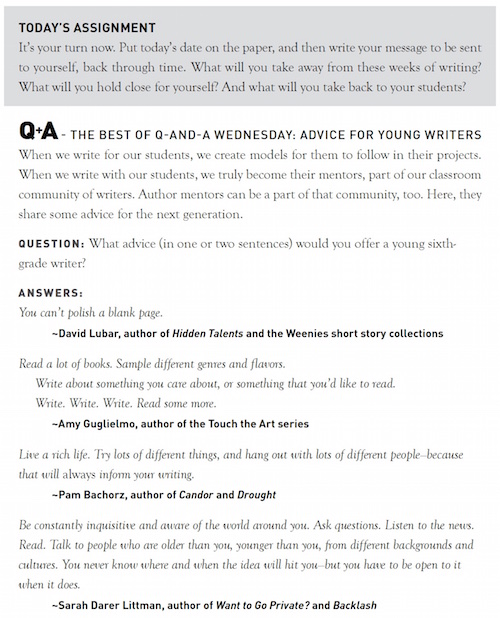59 Reasons: A Guide for Teachers Who Write
59 Reasons to Write: Mini-Lessons, Prompts and Inspirations for Teachers
By Kate Messner
(Stenhouse Publishers, 2015 – Learn more)
 Reviewed by Wendy Moore
Reviewed by Wendy Moore
Scanning through a list of books on writing, I came across 59 Reasons to Write by Kate Messner. My excitement level rose when I read the subtitle “Mini-Lessons, Prompts, and Inspiration for Teachers.” However, to my surprise, the book focused on teachers as writers. This shocking surprise quickly turned into amazement as I sat down to read through this packed book full of tips, writing strategies and author’s notes, finding inspiration to further my own personal writing.
 Overall Organization: The book is broken down into 12 chapters, each focusing on a specific aspect of writing. There are the typical “Setting” and “Plot and Pacing” chapters, but most interestingly there are chapters that combine fiction and nonfiction (“Flowing Between Nonfiction and Fiction: Finding the Story”) and on writer’s block (“I’m Stuck”).
Overall Organization: The book is broken down into 12 chapters, each focusing on a specific aspect of writing. There are the typical “Setting” and “Plot and Pacing” chapters, but most interestingly there are chapters that combine fiction and nonfiction (“Flowing Between Nonfiction and Fiction: Finding the Story”) and on writer’s block (“I’m Stuck”).
The Chapters: Although I typically skip over the introduction, I was pulled in by Messner’s organization. Her Introduction gives reasons to write, assists you in finding the time to write, provides the author’s background (she has written quite a few books herself), and shares teacher dialogue from Messner’s Teachers Write summer camp.
The Narrative: The remaining chapters are broken into four distinct sections: the narrative, Jo’s Morning Warm-Up, the lessons, and the Q & A. The narrative at the beginning of each chapter gives an overview of the lessons in that chapter, focusing on the reason the author included the lesson and points of inspiration for writing, such as “our passions are frequently the best story starters.”
Jo’s Morning Warm-Up: Jo’s Morning Warm-Up, a chapter feature written by YA novelist Jo Knowles, offers short exercises in writing. These ask you to finish sentences, make lists, or even write a few lines about someone you love. The goal, of course, is to get started writing.
The Lessons: The bulk of the book consists of Lessons, about seven per chapter. The lessons are written by a variety of different authors, so the reader gets different ideas and viewpoints. Each lesson has three main parts: a title, a brief author’s reflection on the specific topic (e.g., Lesson 33: “Creating Micro-Tension” by YA author Lisa Schroeder), and a related writing assignment. The titles are self-explanatory which is helpful when flipping through the pages. For example “Characters in Nonfiction” or “Setting a Mood.”
The author commentaries are of high interest but manageable in length, about half to three-quarters of a page, which means you can easily sit down and read them in the amount of time you might take your turn in a Words with Friends game on your phone. They break down the writing, like I do with my students.
In their lessons, the authors do not tell us why they chose a particular word or bit of punctuation but share their train of thought about a particular aspect of their writing, which is helpful as I find my footing as a writer. The third section of each lesson is “Today’s Assignment,” which may offer specific tips on how to improve your writing, or suggest a prompt based on the lesson (“Ask yourself with each scene what you could do to keep readers on the edge of their seats”). Each assignment ends with an image of the contributing author and a brief biography including his/her works.
The Q+A: Each chapter concludes with brief questions to authors about the writing process taken from the “Q&A Wednesday” conversations at Messner’s Teachers Write summer workshops. One question is asked and several writers answer, presenting a variety of different perspectives. Here’s an example from the final chapter, “Time to Reflect” (used with permission):
Inspirational and exciting – with one caveat
As I said in my first paragraph, this book did inspire me to write because of its focus on teachers as writers. After reading it, I felt that as long as I am able to find some time, I already have the skills to write.
The only criticism I have of 59 Reasons to Write is the lack of diversity among the authors chosen to participate. Most of the writers featured are Caucasian females. I would have liked to have seen and been able to read more diverse perspectives to further enrich my work both inside the classroom and within my writer’s group. That said, overall I am very excited about trying the strategies in this book as well as sharing it with my writing colleagues.
Editor’s note: Visitors can review the complete book online at the publisher’s page.
Wendy Moore is an 11-year veteran National Board Certified Teacher currently in the Pittsburgh Public Schools. In addition to teaching English 7, World History 11, Social Studies 7 and Research Methods, she is editing English and Social Studies district curriculum and is a gifted coordinator at her school, SciTech Academy.


































